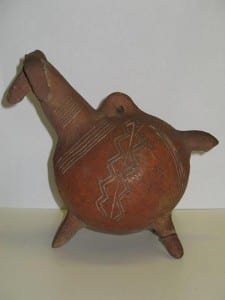Meet the moufflon
By Rachael Sparks, on 15 August 2011
 Never mind the Grant Museum’s much publicised quagga – the Institute of Archaeology has got its own menagerie of strange and rare beasts to enjoy. There isn’t time to explore them all here, so I thought I would introduce you to one of my favourites – a vase in the shape of a moufflon (UCL 844).
Never mind the Grant Museum’s much publicised quagga – the Institute of Archaeology has got its own menagerie of strange and rare beasts to enjoy. There isn’t time to explore them all here, so I thought I would introduce you to one of my favourites – a vase in the shape of a moufflon (UCL 844).
A moufflon, I’ve been reliably informed, is a type of wild sheep. In Cyprus, which is where this vessel comes from, it has become a powerful and widely used national image, appearing in a range of contexts from coinage to airline branding. Immortalised in clay, and far less endangered than the real thing, ours looks rather well-fed and sedate, more suited to a gentle amble over the hills than energetically leaping from crag to crag.
Archaeologists are used to exploring the relationship between man and animal. Animal bone is excavated from ancient sites in great quantities, and the Institute has a large research collection of this sort of material. It can tell us about ancient diets – what animals were being hunted or reared for food, what age they were slaughtered at, what sort of cuts of meat were preferred, and even how the animals were butchered, through cut marks left on the bones themselves. Animals were also reared for their secondary products, like milk or wool, and this can find correlates in associated objects relating to the use of those products, such as churns, spindle whorls, or loomweights.
Animals also played roles other than the purely practical. Animal sacrifices were all the rage in the Near East, with the associated practice of haruspicy (reading entrails) being a popular way of justifying major political or military decisions. A nice archaeological correlate of this is the creation of clay model livers, with cuneiform texts strategically placed over the surface as training devices for the would-be soothsayer (the British Museum and Louvre have some nice examples).
The ideology of kingship also made much of feats of skill and bravery in relation to conquering wild beasts. Thutmose III (1479-1425 BC) went off on an elephant shoot while attempting to subdue Syria. Amenhotep III (1388-1350 BC) issued a special oversized scarab to commemorate hunting down wild bulls, while the lion hunts of the Assyrian king Ashurbanipal (668-631 BC) were immortalised in stone on the walls of his palace at Nineveh. Wild animals also had a role to play in mythology, being associated with powerful deities such as Baal (the bull) and Astarte (the lion). Not to mention the animal-rich iconography of ancient Egyptian religion. My personal favourite is the goddess Taweret, a potent mix of hippopotamus, lion and crocodile. Now there’s a deity I’d certainly want on my side when the chips were down.
How does our moufflon fit into all this? Well, it certainly isn’t a fearsome beast, but a familiar part of the Cypriot landscape, captured in clay and brought into the community for some particular purpose. But what exactly was that purpose?
At first sight, it looks like a vessel, with its hollow, globular body, small opening at the base of the neck, and discreet lug handle on the back. It is certainly very much in the tradition of contemporary, Early Cypriot style pottery (c. 2000-1900 BC), with its highly burnished red slip and snazzy incised decoration. But practically speaking, it would function poorly as a container for liquids. The small hole may simply have been added as an aid to firing, but if so, why is it in such an obvious place rather than underneath the body? Alternatively, the vessel may have been used as a rattle, with the hole designed to allow small pellets to be inserted into the body. The placement of this would certainly stop them falling out too easily. The argument against this of course, is the fact that there are no pellets in place now. But use as a child’s rattle might help to explain the quirky choice of subject matter.
 As animal representations go, this one may not be 100% accurate (how many three-legged lug-handled moufflon have you seen?). But what the artist has done is captured the sheer joyful moufflonness of the creature. So perhaps accuracy was never the aim.
As animal representations go, this one may not be 100% accurate (how many three-legged lug-handled moufflon have you seen?). But what the artist has done is captured the sheer joyful moufflonness of the creature. So perhaps accuracy was never the aim.
You can see our friend the moufflon on display in the A.G. Leventis Gallery of Cypriot and Eastern Mediterranean Archaeology – just right of the foyer as you enter the Institute of Archaeology building.
Perhaps the only thing left to do is give our Moufflon a name. I had thought of Maurice, after its donor, Maurice Scott Thompson; it has a certain alliterative charm. But maybe something Cypriot to honour its ancestry would be more appropriate. Any ideas?
References
Coldstream, J.N. 1992. “A Moufflon Vase in University College London”, in: G. C. Ioannides (ed.), Studies in Honour of Vassos Karageorghis, Nicosia: Society of Cypriot Studies, 101-2, pl. XVI.
 Close
Close

